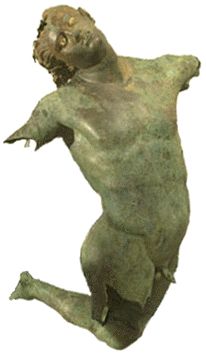...Best of Sicily presents... Best of Sicily Magazine. ... Dedicated to Sicilian art, culture, history, people, places and all things Sicilian. |
by Antonella Gallo | ||
Magazine Index Best of Sicily Arts & Culture Fashion Food & Wine History & Society About Us Travel Faqs Contact Map of Sicily |
The most famous of the satyrs was Pan, the ugly "lesser" god who played the reed "Pan" pipes, and who struck fear into the hearts of woodland nymphs and other young women. To him we owe the word panic, from the Greek panikos. In Roman mythology, Pan was Faunus (Faun), from which the English word fauna, but in Sicily Greek language, culture and mythological tradition predominated well into the region's Roman period. The dancing bronze satyr of Mazara del Vallo, in western Sicily, seems only slightly less lecherous than Pan. In antiquity, he might have attracted less attention, but because many of Sicily's archeological treasures have been carried away to foreign museums, never to return, the dancing satyr, like the recently unearthed classical heads, is an exceptional find. This satyr is similar in style to those depicted on Greek vases. Though always rejected by the beautiful nymphs, Pan was said to have danced with them in the forests and mountains. In this way, the concept of a dancing satyr is not at all unorthodox. Measuring 2.5 metres in height, the satyr is cast in a bronze alloy typical of Roman period castings yet rendered in the Hellenistic style. It was probably part of a group created as early as 300 BC (BCE). The statue was discovered on the floor of the Sicilian Channel under 500 metres of water in 1998. It has found a home in its own museum, the Museo del Satiro, in Piazza Plebiscito in Mazara del Vallo's former Sant'Egidio Church. About the Author: Antonella Gallo, who teaches art in Rome, has written numerous articles on arts and artists for Best of Sicily. | |
Top of Page |
 The satyr. Among the quasi-human beings of Greek mythology
were various creatures, essentially human, bearing certain animal
features. The centaur (the archer of Sagittarius) was a
man with the four legs of a horse; the minotaur (of the
Minoan labyrinth) was a man with the four legs of a bull. Mermaids
and mermen bore the torso, head and arms of humans with,
in place of legs, the tail of a fish. The sileni were half
man and half horse or goat, but with two legs instead of four.
The two-legged satyrs (Greek saturos) were goat-men,
usually similar to the caprine sileni, but sometimes depicted
as entirely human except for having the ears, horns, hooves and
tails of goats. Usually priapic, the satyr was said to be lecherous,
and a band of dancing, happy satyrs accompanied the drunken god Dionysos.
The satyr. Among the quasi-human beings of Greek mythology
were various creatures, essentially human, bearing certain animal
features. The centaur (the archer of Sagittarius) was a
man with the four legs of a horse; the minotaur (of the
Minoan labyrinth) was a man with the four legs of a bull. Mermaids
and mermen bore the torso, head and arms of humans with,
in place of legs, the tail of a fish. The sileni were half
man and half horse or goat, but with two legs instead of four.
The two-legged satyrs (Greek saturos) were goat-men,
usually similar to the caprine sileni, but sometimes depicted
as entirely human except for having the ears, horns, hooves and
tails of goats. Usually priapic, the satyr was said to be lecherous,
and a band of dancing, happy satyrs accompanied the drunken god Dionysos.